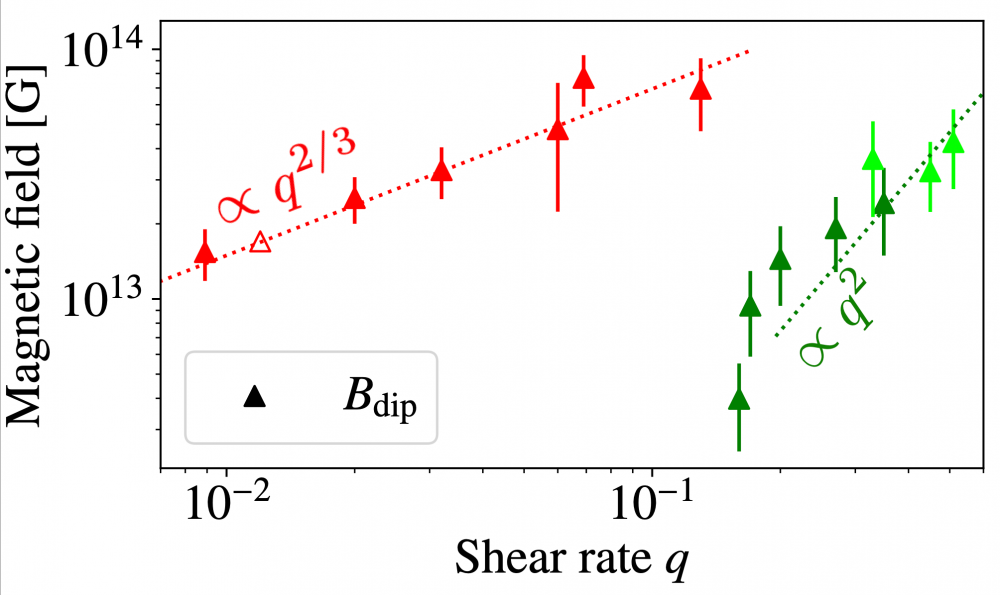Magnetars are neutron stars displaying the most intense magnetic fields observed in the Universe. To tackle the still-open question of the origin of these extreme magnetic fields, a scenario was proposed by a team from the Department of Astrophysics (DAp) at CEA Saclay, invoking the Tayler-Spruit dynamo mechanism, triggered by matter falling onto the young neutron star after the supernova explosion. The team of scientists had shown in 2022 through analytical analysis that this type of dynamo could explain the intensity of the magnetic field of magnetars. In this new study, the team confirms this result through three-dimensional numerical simulations. This will have significant implications for understanding the origin of magnetic fields, not only for magnetars but also for stellar evolution where the same dynamo mechanism could be at work.
This new study was published in the journal Monthly Notices of the Royal Astronomical Society: Letters.
Neutron stars are the result of the violent contraction of the iron core of a massive star during its gravitational supernova explosion. They have a radius of about 12 km and a mass of 1 to 2 times that of the Sun, which implies extreme density. Magnetars are a special class of neutron stars. They emit mainly in X-rays due to the dissipation of an extremely intense magnetic field which, in combination with very rapid rotation, can trigger extremely energetic supernovae, such as hypernovae and super-luminous supernovae.
The question of magnetar formation, as well as the associated scenario of extreme explosions, is still hotly debated, but a promising scenario is the amplification of the magnetic field by a dynamo effect in a proto-neutron star.
Dynamo effects, which are certainly responsible for the majority of astrophysical magnetic fields, are complex instability processes coupling the movements of a fluid and its magnetic field to amplify and maintain the latter in a self-sustaining manner. Two types of dynamos have been studied within the supernova team of the Department of Astrophysics at CEA Saclay, one is maintained by convective movements and the other by a magnetohydrodynamic instability due to the differential rotation of the fluid. These scenarios help to recover the intensity of the magnetic field of magnetars and extreme explosions. However, these dynamos require that the core of the progenitor star be rotating rapidly, which is still uncertain and probably too rare to explain the entire observed population.
A third scenario proposed by this same team suggests that the rapid rotation of the proto-neutron star comes from matter falling back onto its surface about 10 seconds after the beginning of the explosion. This triggers a dynamo maintained by the Tayler-Spruit instability, a toroidal magnetic field instability when it becomes too intense, to the detriment of the other two dynamo mechanisms.
"This new scenario complements the previous two, as it does not require a rapidly rotating core to generate a magnetar. Thus, it applies more to magnetars formed within supernovae with typical energies, while the other two are better suited to magnetars born in more energetic explosions, involving a rapidly rotating core," explains Paul Barrère, lead researcher of this study.

Figure 3 - Magnetic dipole intensity as a function of rotational speed variation along the radius measured locally in simulations of dipolar (red) and hemispherical (green) dynamos. These simulations agree with the theoretical predictions (dotted lines) of Fuller et al. 2019 (red) and Spruit 2002 (green).
The existence of the Tayler-Spruit dynamo has long been debated. After an initial analytical study showing that this mechanism could contribute to the formation of magnetars, researchers from the supernovae team at DAp and the Max Planck Institute for Gravitational Physics have made a significant breakthrough by studying it through three-dimensional numerical simulations. These simulations resulted in the reproduction of the magnetic dipole, with an intensity of 10^14 G, corresponding to the magnitude observed in magnetars, thus confirming the existence of the Tayler-Spruit dynamo.
In addition, the simulations lead to the unexpected discovery of the existence of two distinct types of Tayler-Spruit dynamos, distinguished by the intensity and geometry of the magnetic field they generate. Figure 2 shows the magnetic field is either concentrated in one hemisphere (left) or has a dipole symmetry with respect to the equator (right). Furthermore, these Tayler-Spuit dynamos respectively align with the theoretical predictions of Spruit 2002 and Fuller et al. 2019 (see Figure 3), emphasizing the relevance of this new scenario.
"In addition to making a significant step forward in understanding the formation of magnetars, this study will have a broader impact in the field of stellar physics, particularly on the issue of angular momentum transport leading to the slowing down of the rotation of stellar cores," adds Paul Barrère.
The team is currently continuing this work by studying the impact of different physical parameters on Tayler-Spruit dynamos, aiming to better understand the formation of magnetars and deepen our understanding of these dynamos.
Contacts : Paul Barrère, Jérôme Guilet, Raphaël Raynaud
• Thèmes de recherche du Service d'astrophysique › Modélisation-SAp
• Institute of Research into the Fundamental Laws of the Universe
